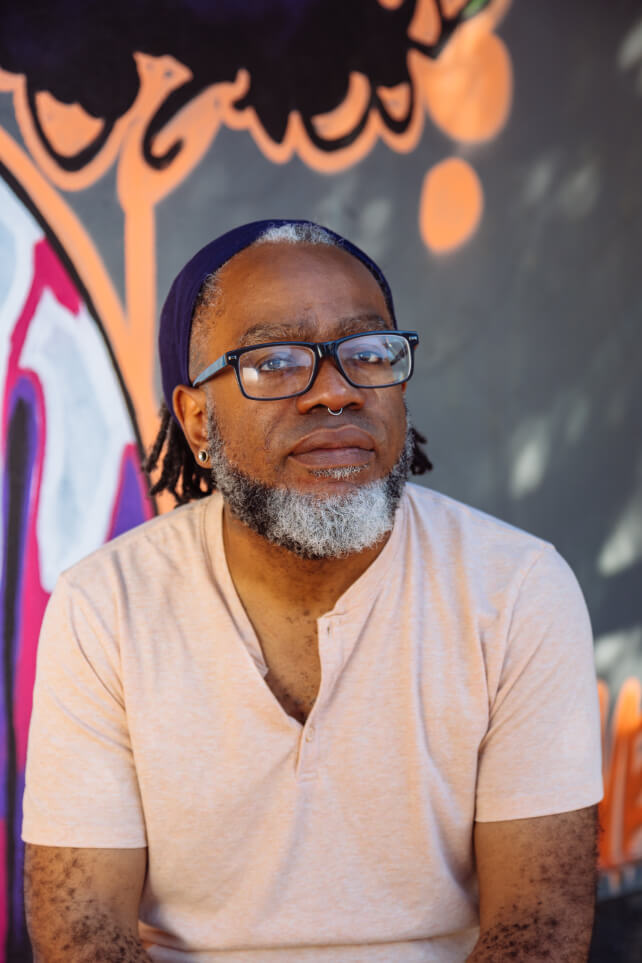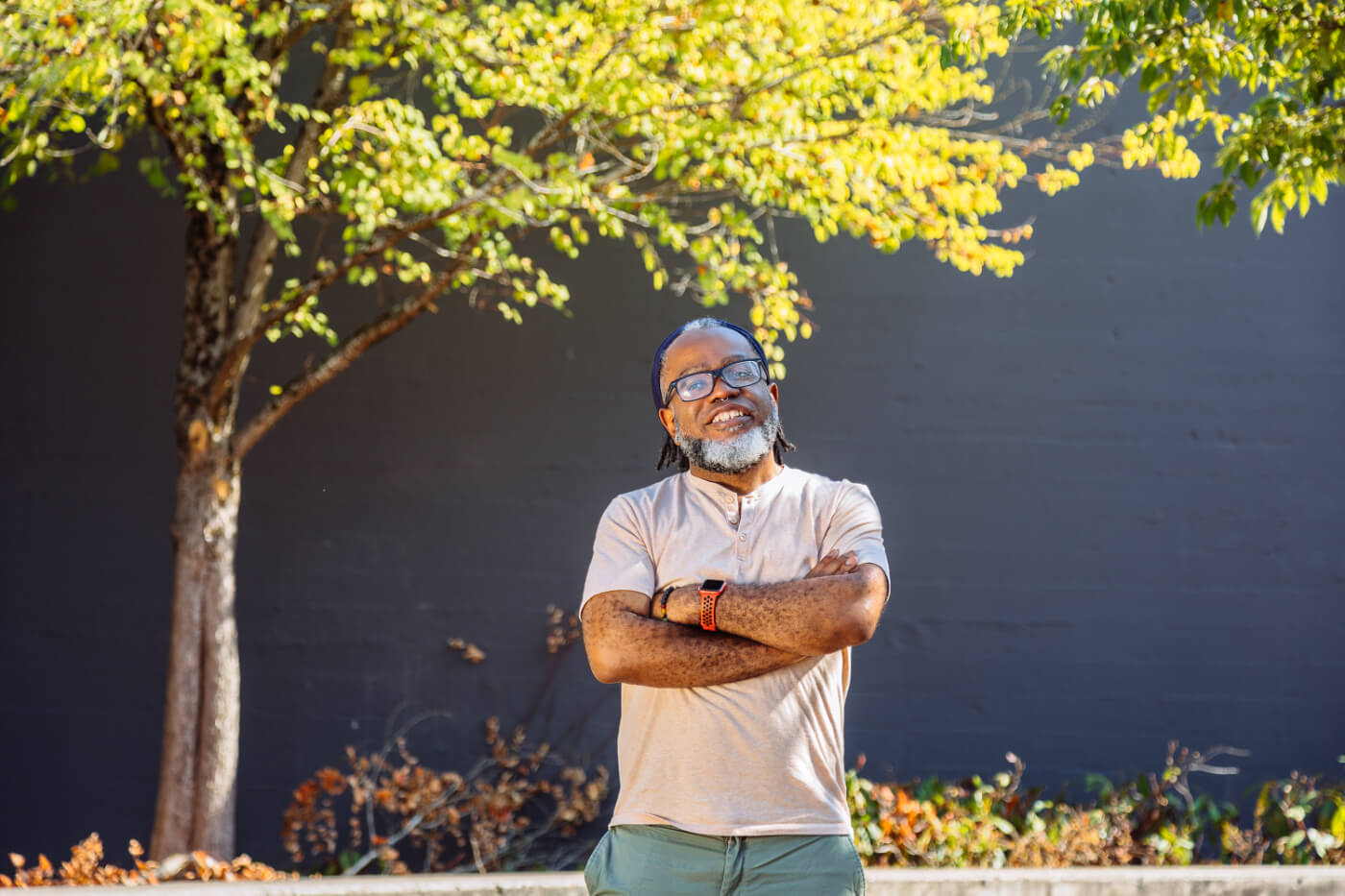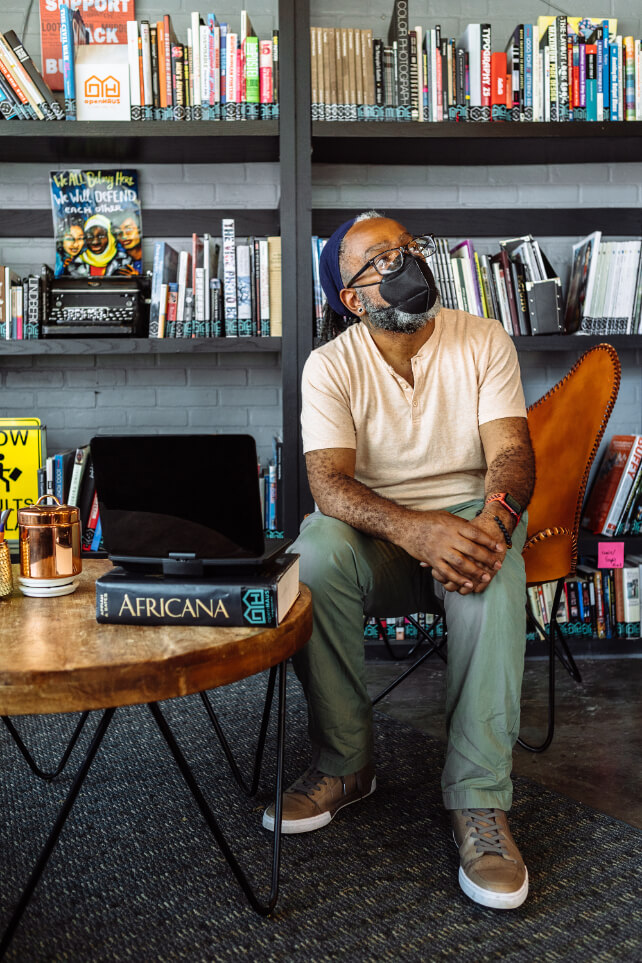December 30, 2022
Disabled And Here: Interview with Andre
Hi Andre! How would you like to introduce yourself? Aye, I’m Andre Gray and I am Black and Deaf, I am leaning on my pronouns to be we/us/ours. Lowkey hustling as a Porter, yet sharing, creativity, and accessibility are passions of mine. You might find me making moves throughout Portland slightly disoriented due to gradual vision loss.

What brought you to Portland? How does it compare to previously living in Austin and Indianapolis? I moved to Oregon from Austin after being offered an opportunity to continue working as a residential educator at a local Deaf school. Originally, my impression was this would be a full time job, but it ended up being one, two, three or zero shifts per month as a substitute. I’ve grown to be okay with it, although this gig wasn’t the only hook as far as moving to PNW. I was drawn to this space knowing Portland was huge on creativity and it met my desire to get into art, media and tattoo culture.
I honestly felt more welcomed to Austin than I did in Indianapolis, even though I lived my whole life in Naptown (Indy). My hometown just felt as if people like me were always held at minimum standards while those who paid to play, or were privileged and able-bodied could absorb opportunities, even if those opportunities weren’t meant for them.
Both Austin and Indianapolis provided the sky with frequent wild thunderstorms. But Portland never really granted us those experiences. Aside from the lack of storms, I felt like Portland was more accessible in terms of transportation, finance, housing. I know it’s hard to believe, but I just felt like Portland allowed me to expand past my own capacity. While other cities held us in an invisible red-lined cage.
Can you tell us more about your project Beyond Tone? Beyond Tone was my first step in creating entertainment accessible to our Deaf community. A void was created in my life when I left a massive Deaf Community in Austin, Texas. I came to realize that I no longer had a direct connection with Deaf people. At some point, I wanted to start watching TV again, but noticed a lot of streaming programs had no captions. Nor were there any available programs in American Sign language.

My focus of becoming a tattoo artist became smaller, but greater in creating a solution and accessibility for our community. With that being said, I began with surveying everyone, building and publishing articles on Beyond Tone’s website, then later became involved with Deaf storytellers and visual artists.
At this point, I have gathered a decent amount of documentaries in American Sign Language. I soon plan to release references for ASL documentaries through a series of Video Podcasts in American Sign Language. I plan to keep developing more ASL programming until all media is equally accessible to the Deaf and Hard of Hearing [HoH] community.
Yes to all the accessibility! What have been some of your favorite creative endeavors over the years? I really enjoy learning from my colleagues at CymaSpace, a Portland nonprofit that focuses on accessibility and accelerating Deaf artists. This organization opened my eyes and soul to a variety of artists, art programs, and other collaborative nonprofits. At PICA, Portland Institute of Contemporary Arts, I was invited to collaborate for a TBA [Time-Based Art] project as a Camera Operator and a Panel Host for Disability conversations.
I am also a member of the Portland Deaf Film Festival team, which is entirely led by passionate grassroot Deaf Leaders & artists. PDXDFF showcases Deaf-created content not only from Portland, but from around the world.
My total favorite is Deaf Artist Retreat. I recently returned from my third event. Events like these are where 7 to 16 Deaf artists come together from all over the country and collaborate with multiple photo/video installations. Retreats like these also give a chance for us to learn techniques that we couldn’t gain from other events that don't offer sign language. It also allows an opportunity to reclaim space and time where we are not an outcast, or viewed as difficult to communicate with.
If you could magically transform the world into a more accessible place, what specifically would you design or put in place? Now if I was to make this world more accessible, instead of pretending disability [and disabled] people are the lesser members of society, I would rewrite history where everyone is aware and acknowledges that we all came from people of color, we all came from people with disabilities.

What are some things you do to relax or just for fun? How do I have fun? Food! I enjoy food as much as people who can hear and enjoy music. Music is often written to share a story with the audience. I get the same vibe with plates, a lot of chefs out here executing stories through their dishes, and it’s as if I can understand the dialect between the knives and the final dish presentation.
Is there anything else you’d like to share as we wrap up? It would be helpful if people wouldn’t be so resistant to turning on the captions, making sure the lips are visible when they speak (now please don’t ask us to read lips, it's just a no no) just look us in the eyes and talk with a clear face. Plan your interpreter 14 days or more in advance for shows or meetings, instead of waiting til the last minute with, “Oh hey there we tried, but no one was available.” This response is definitely played out and demonstrates if the person understands the importance of accessibility or not.
Final question: what are the best ways to support you AND your work? Again be patient with us, allow us to gain the same amount of information that everyone else gets to process.
You can find me and my work at @playdregray on Instagram. Also check out BeyondTone for current materials and stay tuned for exciting new projects such as the podcast or art/film festival projects.
This interview has been edited for clarity.